[高一英语]Module3 Music教案
- 格式:doc
- 大小:38.50 KB
- 文档页数:2
![[高一英语]Module3Music教案](https://uimg.taocdn.com/29faa1136294dd88d1d26b24.webp)
Module3 Music Reading and vocabularyStep1. Lead-in(导入)Step2. Fast reading(快读)Read the passage quickly and choose the best title.1. Three Great Austrian Composers2. Three Great Composers of the Eighteenth Century3. Three Great Child ComposersStep3. Careful reading(精读)★ Read Part (Ⅰ) about Haydn and answer the following questions. (回答问题)1. What is Haydn known as?2. How did Haydn change the form of symphony ?3. How long did he work in eastern Austria?★ Read Part (Ⅱ) about Mozart and match the time with the right information.(信息匹配)1)at a very early age a. toured Europe giving concerts2)when he was 4b. played the harpsichord in a concert for the Empress of Austria3)when he was 5 c.showed musical talent4)when he was 6 d. learned to play the harpsichord5)by the time he was 14 e.started composing music6)when he was a teenager f. composed many pieces for the harpsichord, piano and violin ★ Read Part (Ⅲ ) about Beethoven & decide if these sentences are true or false.(判断正误)1. Beethoven was born in Austria.2. Beethoven learned to play the violin and piano from his father, who was a singer.3. Beethoven met Haydn in 1781.4. Hadyn encouraged Beethoven to move to Vienna.5. When Beethoven became completely deaf, he stopped composing.Step4. Consolidation(巩固练习)Three Great Composers of the Eighteenth CenturyHaydn, who __ _____ __“the father of the symphony”, was the son of a peasant.He________the symphony ____ a long piece for a large orchestra. ______ ______ in eastern Austria for 30 years, Haydon moved to London, _______ he was very successful.Mozart was a composer, possibly the greatest musical genius ____ ____ _____ . He had ______ ______ from a very early age. By the time he was 14, Mozart had ________ many pieces for the harpsichord, piano and violin, ____ ______ _____for orchestras. Haydn was _________with Mozart when he first met him.Beethoven was born in Bonn, Germany. He ________ musical talent when he was young. In his twenties, he met both Mozart and Haydn. However, it was Haydon who __________him to move to Vienna. ___ he grew older, he began to ___ ____. But he________ _________ .Step5. Role-playing(角色扮演)Work in pairs. Make a dialogue about the three composers. student A acts as an interviewer and student B acts as one of the composers.The students can make the dialogue with the following clue.Interviewer: Good morning, Mr.……Composer: Good morning.Interviewer: Would you mind me asking a few questions ?Composer: Of course, not.I nterviewer: When……/ Where……/What…… Composer: ……Interviewer: Thank you very much for your poser: It’s my pleasure.Step6. Homework According to the information, write a short passage about Jay Zhou.。
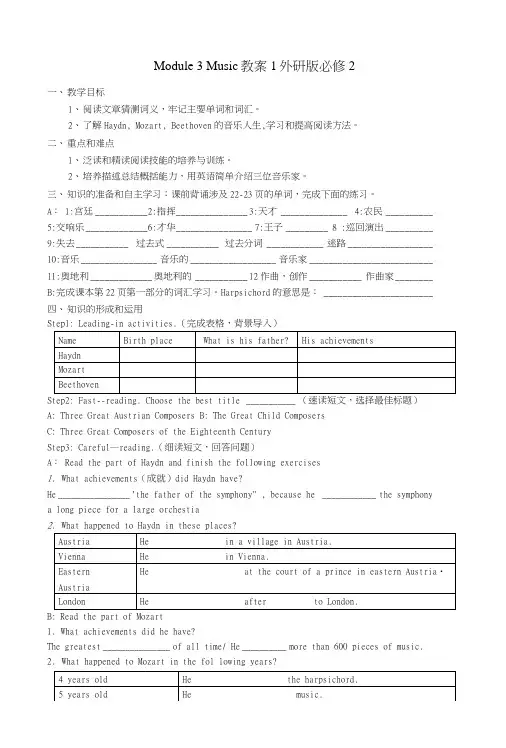
Module 3 Music教案1外研版必修2一、教学目标1、阅读文章猜测词义,牢记主要单词和词汇。
2、了解Haydn, Mozart, Beethoven的音乐人生,学习和提高阅读方法。
二、重点和难点1、泛读和精读阅读技能的培养与训练。
2、培养描述总结概括能力,用英语简单介绍三位咅乐家。
三、知识的准备和自主学习:课前背诵涉及22-23页的单词,完成下面的练习。
A: 1:宫廷___________ 2:指挥_______________ 3:天才 ______________ 4:农民__________ 5:交响乐_____________ 6:才华________________ 7:王子_________ 8 :巡回演出__________ 9:失去___________ 过去式___________ 过去分词 ____________ 迷路__________________ 10:音乐________________ 音乐的__________________ 音乐家__________________________ 11:奥地利_____________ 奥地利的___________ 12作曲,创作___________ 作曲家________ B:完成课本第22页第一部分的词汇学习。
Harpsichord的意思是: _______________________ 四、知识的形成和运用Stepl: Leading-in activities.(完成表格,背景导入)Step2: Fast--reading. Choose the best title ___________ (速读短文,选择最佳标题)A: Three Great Austrian Composers B: The Great Child ComposersC: Three Great Composers of the Eighteenth CenturyStep3: Careful―reading.(细读短文,回答问题)A: Read the part of Haydn and finish the following exercises1.What achievements(成就)did Haydn have?He ________________ 'the father of the symphony" , because he ____________ the symphonya long piece for a large orchestia2.What happened to Haydn in these places?B: Read the part of Mozart1.What achievements did he have?The greatest _______________ of all time/ He __________ more than 600 pieces of music. 2.What happened to Mozart in the fol lowing years?C: Read the part of Beethoven1. Try to translate the sentence into Chinese・However, it was Haydn who encouraged Beethoven to move to Vienna・2.What happened to him as he became old?As he grew older, he began to _________________ b ut he ________________________ e venwhen he became completely deaf・3.What achievements did he have?He ________________________ i n Austrian capitai and stayed there for _______________Step!: Post―reading.(回过头再来完善stepl的表格,整体了解3位咅乐家)Ste P5:合作探究.(以Mozart为例,分析篇章结构,总结如何描写名人)从下列各项中选出文中描写到的项,并把它们填入表格来完成文章的结构图表。
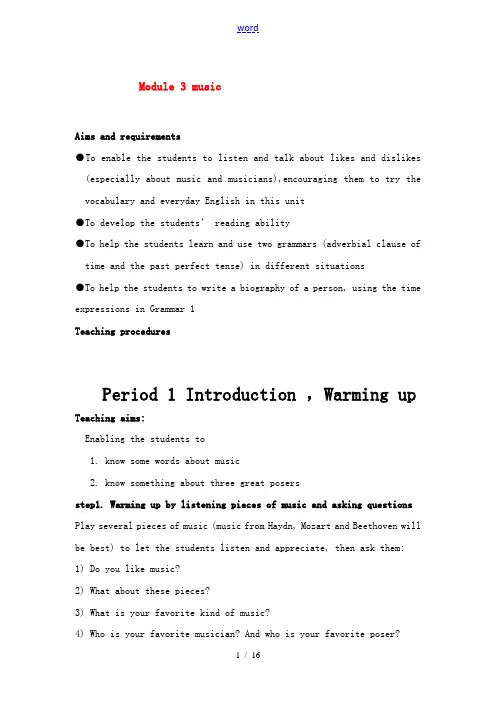
Module 3 musicAims and requirements●To enable the students to listen and talk about likes and dislikes (especially about music and musicians),encouraging them to try the vocabulary and everyday English in this unit●To develop the students’ reading ability●To help the students learn and use two grammars (adverbial clause of time and the past perfect tense) in different situations●To help the students to write a biography of a person, using the time expressions in Grammar 1Teaching proceduresPeriod 1 Introduction ,Warming up Teaching aims:Enabling the students to1. know some words about music2. know something about three great posersstep1. Warming up by listening pieces of music and asking questions Play several pieces of music (music from Haydn, Mozart and Beethoven will be best) to let the students listen and appreciate, then ask them:1) Do you like music?2) What about these pieces?3) What is your favorite kind of music?4) Who is your favorite musician? And who is your favorite poser?step2. Warming up by showing some pictures and discussing1) Do you know who they are?2) What kind of things are these pictures connected with, science, culture, politics, painting, drawing or music?step3. Warming up by listening to a piece of musicGood morning, class. Today we are going to read a passage about three great musicians who are all posers. A poser is a musician who writes pieces of beautiful music for others to sing or to play. Now,let’s listen to a piece of music.(the teacher plays a piece of music ----er quan yingyue)1.do you know what kind of music it is?2.whose work is it?3.what kind of music is it?4.what is your feeling after listening to it?Step 4 show the following picturesAnd make the students familiar with these new words:Piano violin saxphone drum erhu guitarste p4.now please match these musical instruments with their names.Step 5 work in groups to discuss these questions:1.which of the instruments do you like listening to?2.which famous musicians play them?3.is the chinese instruments different from the otherinstruments?describe the difference,if there is one.Step6 summary and homework:Today we’ve learnt the Introduction,know something about music,and we’ve also learnt some new words.The homework:1.Try to instruct your favorite musician to your class orally.2.Learn the new words again, using the dictionary if necessaryPeriods 2 Reading and Vocabulary Teaching Aims:Train the students' reading ability.Learn some useful words and expressions.Teaching Important Points.Help the students to understand the passage better.Learn and master some important words and phrases in this period. Teaching Difficult Points:How to help the students improve their reading and understand the passage better.Teaching Methods:Fast reading to get the general idea of the text.Careful reading to understand the passage better.Discussion to help the students understand what they've learned better. Teaching procedure.Step 1 Lead --inThe teacher may play a kind of music written by Beethoven.------- What kind of music do you think it?----- Who do you know wrote it ?The teacher may discuss the questions and answer them freely.T: As we know, there are various kinds of music around the world. They all have their own obvious characteristic. And also there were famous posers such as Joseph Haydn, Mozart, and Beethoven. Today we may learn of their life from the text.Step 2 Reading prehension.Fast reading: Read the passage quickly and choose the best title.A.Three Great Austrian posers.B.Three Great poser of the eighteenth Century.C.Three Great Child posers.Key: B.Now let's read the passage again, underline new words in the text and decide whether the following statements are right or not.1.The three posers were all born in Austria.2.Mozart had a beautiful singing voice.3.Mozart died before his fortieth birthday.4.Beethoven once worked at the court of a prince, who began to go deaf when he grew older.5.Beethoven had ever met Haydn, but he didn't think he taught him a lot.6.Both Haydn and Mozart had fathers who were musicians.Key:1.F Beethoven was born in Bonn, Germany.2.F. Haydn had a good singing voice.3.T4.F. Haydn once worked at the court of a prince, but he didn't go deaf.5.T6.F. Haydn was the son of a peasant( The teacher may begin with the T/F questions orally and this is a good time to test their listening abilities as well as their prehension of the text. )Step 3 Read and listen to the passage. Meanwhile, some more questions are waiting for you.1.How did Haydn change the form of symphonies?2.How long did he work in eastern Austria?3.How many pieces of music did Mozart pose?4.How old was he when he played for the Empress of Austria?5.How long were Mozart and Haydn friends?6.Who taught Beethoven how to play the piano?7.Did he stop posing when he became deaf?Keys:1 He changed the symphony into a long piece for a large orchestra.2. 30 years.3.More than 600 pieces of music.4. When he was 6 , he played the harpsichord in a concert for the Empress of Austria.Periods 3, Function and GrammarTeaching aims:1 To learn grammar rules2 To use the grammar rules for correctmunication3 To study co-operatelyTeaching important points: To use the correct tense and theproper conj.Teaching difficult points:To use correctly the two tenses andthe three conj.Teaching methods: Explanation and practiceTeaching procedure:Step Ⅰ Lead-in by telling the class what happened to the Shenzhou Ⅻand technology is developing rapidly, China hasachieved a lot in the area of.Shenzhou Ⅻscientists,engineers and the whole nation were waiting andI couldn’t help getting exciteed. I feel proud of our country. Step Ⅱ Grammar 11 Make sentences with “when , while, e in , have a lesson” ( Here is a picture of a classroom and a student ing in)A When he came in, we were having a lesson.B When we were having a lesson, he came in.C While we were having a lesson, he came in.2 Say the meaning of “as” in the following sentences.D As he was a child, he studied drawing.E As he grew older, he began to go deaf.F He listened to music as he walked.当…之时随着一边…一边…3Answer the three questions.When we talk about a single event in the past,we use when asin A .When we talk about a period of time in the past,we use when/ while/ as as in B C D.We use as to refer to a progressive change as in E F .4Practiceplete the following sentences with “when ,while , as”(1) ___she was studying at school, she also sang in the schoolchoir.(2) ___he was living in Vienna, he studied music.(3) ___she met bach,she was only 20 years old.(4) ___he grew older, he found it more difficult to pose music(5) ___he was playing in the orchestra, he met his wife.(6) ___he was working in Hollywood, he became ill and died.(7) ___I listened to the violin solo, I fell in love withclassical music.(8) ___they toured Europe for 10 years, they finnally decidedto live in Austrilia.Step Ⅲ Grammar 2 The past perfect tense1Read the following sentences and summarise rules, paying attention to tenses. Fill in the blanks.After Liping had finished doing his homework, he turned on the TV. After they had got everything ready, they began to do the experiment. Before he came to our school, he had taught English for several years. Before his letter reached me, I had received his telephone call.They had finished the project by last month.I had left the country by the time the letter reached me.had done before diddid after had donehad done by did/past time2 PracticeWorkbook Grammar (2)(3)(4)plete the sentences using the verbs in brackets and the past simple or past perfect tense.Step Ⅳ1 Game Oral practice ,pair work.Ask and answer questions using all kinds of tenses.Example:-- When did you have your breakfast this morning?-- At 6.-- Have you prepared for the English lesson?-- Yes, I have. I have finished the exercises in the workbook.2 Watch a vedio play.Step Ⅴ Sum upAsk some students to make sentences using “when, while, as, before, after, by”.Step Ⅵ Homework: Present a biography of a famous Chinese musician orposer.Periods 4 Speaking and Writing Teaching Aims:1.Knowledge and Skilla.To develop speaking ability by talking about likes and dislikes.b.To learn about some vocabulary and knowledge related to music andposers.c.To develop writing ability by presenting a biography of a famousChinese musician or poser.d.Train the ability of collecting and dealing with information, anddevelop their abilities of getting new information, munication and cooperation.2.Emotion and Valuesa.To raise students’ interests in science and form the right attitudetowards all kinds of music.b.To help them know Chinese traditional music well and cultivate theirinterest in playing some Chinese instrument.3. Character-building:a.To make them know how to enjoy different kinds of music.b.Arouse their interest of playing some kinds of instrument and enrichtheir leisure time.4. Cross-cultural awarenessa.To help them know the difference between China and some westerncountries in instruments.b.Cultivate their awareness of cultural munication through the speciallanguage—music.Difficulties and Importance:a.To make the students understand and grasp the vocabulary andknowledge related to music.b.To enable the students to know how to use adverbial clause of time. Teaching Method:a.Task-based methodologyb.municative ApproachTeaching Procedures:Step 1 Pre-readingLook at the picture and answer the following questions.1.Who is he?2.Have you ever know something about him?Step 2 While-readinga. SkimmingRead the passage quickly, and make a note of some basic information about Ye xiaogang.Suggested answers:b. Detailed readingRead the passage carefully and fill in the blanks with proper words. Find what Ye Xiaogang did or what happened to him in the following years:Suggested answers:Step 3. Post-readingDiscussion.1.Are there any similarities between Ye Xiaogang and the European posersyou have read about in this module?2.Do you think it is a good idea to mix Chinese and western music? Step 4 Everyday Englisha. Listen to two people talking about the way they listen to music and answer the questions.1.How do they listen to it?2.Are they happy with the way they listen to music?3.What does Anna offer to do for Tom?b. work in pairs. Discuss your favourite music and how you listen to it. Step 4 Guided writingWrite a short passage of a famous singer in China—Han Hong.The following words may help you:1. sing well successful song writer2.born in1971 in Tibet(某某)3. young watch her mother sing and dance4. at the age of nine professional(专业的) training in Beijing.5. in 1985 her first national prize6. write songs in 19937. song Hometown number one in ChinaHomework:1.Finish writing the biography of Han Hong—a famous Chinese singer.2.Finish other exercises in this module.Periods 5 culture cornerTeaching aims:Enabling the students to1. to know sth about Ye Xiaogang2. write a biography of a famous Chinese musician or poser.Teaching steps:I. Ask some students to say something about Mozart.Give as many details as possible.II. Try to think of a Chinese musician or poser, eg. Xu Peidong.Gather these materials.1. when, where and in what kind of family he/ she was born.2. how he/ she spent his/ her childhood or youth.3. about his/ her education4. what are his/ her famous works5. what his/ her style is / wasGroup work. Ask the students to discuss about the musician or poser. Then ask some students to stand up to say sth. about the musician or poser. Correct the mistakes if any.III. Cultural Corner.Ye Xiaogang1. Listen to the passage and try to find the answer to this question: When did his album Horizon appear? (in 1986)2. Read the passage thoroughly and make a note of the information about Ye Xiaogang.Name:_________________ Sex: __________________Nationality:_____________ Job:___________________Main achievements: ____________________________________________Style of music: ____________________________What he did or happened to him in the following years:1955: ___________________________________________From 1978 to 1983: ___________________________________________1985: ___________________________________________1986: ___________________________________________1996: ___________________________________________3. Check the answers with the whole class. Then ask one or two students to say sth about Ye Xiaogang with the help of the notes made.4. Language points:1) work as2) leading modern posers 主要作曲家leading article 社论the leading cause 主要原因a leading role 主角3) mix A with B= mix A and B togethermix win with waterNever mix with such people.mix up 弄混,弄错It’s mon to mix him up with his brother.弄乱mix up the papersmix up those data4) receive many prizes5) part ofIV. Homework:Write a short passage about the Chinese musician or poser we talked about this period.。
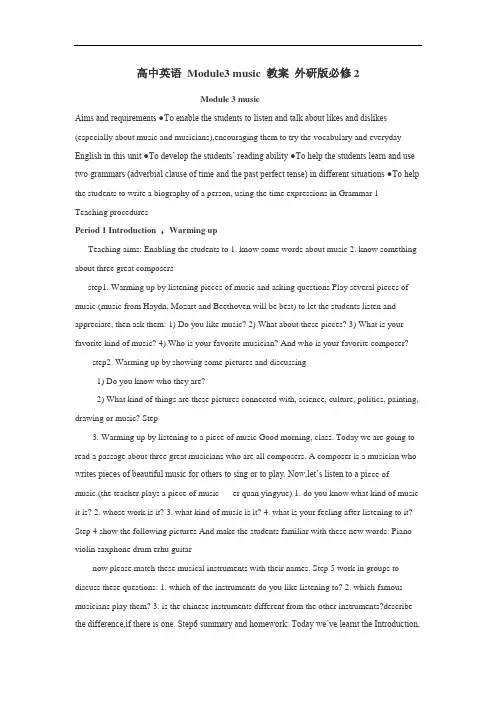
高中英语Module3 music 教案外研版必修2Module 3 musicAims and requirements ●To enable the students to listen and talk about likes and dislikes (especially about music and musicians),encouraging them to try the vocabulary and everyday English in this unit ●To develop the students’ reading ability ●To help the students learn and use two grammars (adverbial clause of time and the past perfect tense) in different situations ●To help the students to write a biography of a person, using the time expressions in Grammar 1 Teaching proceduresPeriod 1 Introduction ,Warming upTeaching aims: Enabling the students to 1. know some words about music 2. know something about three great composersstep1. Warming up by listening pieces of music and asking questions Play several pieces of music (music from Haydn, Mozart and Beethoven will be best) to let the students listen and appreciate, then ask them: 1) Do you like music? 2) What about these pieces? 3) What is your favorite kind of music? 4) Who is your favorite musician? And who is your favorite composer?step2. Warming up by showing some pictures and discussing1) Do you know who they are?2) What kind of things are these pictures connected with, science, culture, politics, painting, drawing or music? Step3. Warming up by listening to a piece of music Good morning, class. Today we are going to read a passage about three great musicians who are all composers. A composer is a musician who writes pieces of beautiful music for others to sing or to play. Now,let’s listen to a pi ece of music.(the teacher plays a piece of music ----er quan yingyue) 1. do you know what kind of music it is? 2. whose work is it? 3. what kind of music is it?4. what is your feeling after listening to it? Step 4 show the following pictures And make the students familiar with these new words: Piano violin saxphone drum erhu guitarnow please match these musical instruments with their names. Step 5 work in groups to discuss these questions: 1. which of the instruments do you like listening to? 2. which famous musicians play them? 3. is the chinese instruments different from the other instruments?describe the difference,if there is one. Step6 summary and homework: Today we’ve learnt the Introduction,know something about music,and we’ve also learnt some new words. The homework: 1.Try to instruct your favorite musician to your class orally. 2.Learn the new words again, using the dictionary if necessaryPeriods 2 Reading and VocabularyTeaching Aims: Train the students' reading ability. Learn some useful words and expressions. Teaching Important Points. Help the students to understand the passage better. Learn and master some important words and phrases in this period. Teaching Difficult Points: How to help the students improve their reading and understand the passage better. Teaching Methods: Fast reading to get the general idea of the text. Careful reading to understand the passage better. Discussion to help the students understand what they've learned better.Teaching procedure. Step 1 Lead --inThe teacher may play a kind of music written by Beethoven. ------- What kind of music do you think it? ----- Who do you know wrote it ? The teacher may discuss the questions and answer them freely. T: As we know, there are various kinds of music around the world. They all have their own obvious characteristic. And also there were famous composers such as Joseph Haydn, Mozart, and Beethoven. Today we may learn of their life from the text. Step 2 Reading comprehension.Fast reading: Read the passage quickly and choose the best title. A. Three Great Austrian Composers. B. Three Great Composer of the eighteenth Century. C. Three Great Child Composers. Key: B. Now let's read the passage again, underline new words in the text and decide whether the following statements are right or not. 1. The three composers were all born in Austria. 2. Mozart had a beautiful singing voice. 3. Mozart died before his fortieth birthday. 4. Beethoven once worked at the court of a prince, who began to go deaf when he grew older. 5. Beethoven had ever met Haydn, but he didn't think he taught him a lot. 6. Both Haydn and Mozart had fathers who were musicians. Key: 1. F Beethoven was born in Bonn, Germany.2. F. Haydn had a good singing voice.3. T4. F. Haydn once worked at the court of a prince, but he didn't go deaf.5. T6. F. Haydn was the son of a peasant ( The teacher may begin with the T/F questions orally and this is a good time to test their listening abilities as well as their comprehension of the text. ) Step 3 Read and listen to the passage. Meanwhile, some more questions are waiting for you. 1. Howdid Haydn change the form of symphonies? 2. How long did he work in eastern Austria? 3. How many pieces of music did Mozart compose? 4. How old was he when he played for the Empress ofAustria? 5. How long were Mozart and Haydn friends? 6. Who taught Beethoven how to play the piano? 7. Did he stop composing when he became deaf? Keys: 1 He changed the symphony into a long piece for a large orchestra. 2. 30 years. 3. More than 600 pieces of music. 4. When he was 6 , he played the harpsichord in a concert for the Empress of Austria.Periods 3, Function and GrammarTeaching aims:1 To learn grammar rules 2 To use the grammar rules for correct communication 3 To study co-operately Teaching important points: To use the correct tense and the proper conj. Teaching difficult points: To use correctly the two tenses and the three conj. Teaching methods: Explanation and practice Teaching procedure: Step ⅠLead-in by telling the class what happened to the Shenzhou ⅫAs science and technology is developing rapidly, China has achieved a lot in the area of.Shenzhou Ⅻlaunched when/while scientists,engineers and the whole nation were waiting and watching.When I came back home from school and heard the news,I couldn’t help getting exciteed. I feel proud of our country. Step ⅡGrammar 11 Make sentences with “when , while, come in , have a lesson” ( Here is a picture of a classroom and a student coming in)A When he came in, we were having a lesson.B When we were having a lesson, he came in.C While we were having a lesson, he came in. 2 Say the meaning of “as” in the following sentences.D As he was a child, he studied drawing.E As he grew older, he began to go deaf.F He listened to music as he walked. 当?之时随着一边?一边? 3 Answer the three questions. When we talk about a single event in the past,we use when as in A . When we talk about a period of time in the past,we use when/ while / as as in B C D. We use as to refer to a progressive change as in E F . 4P ractice Complete the following sentences with “when ,while , as” (1) ___she was studying at school, she also sang in the school choir. (2) ___he was living in Vienna, he studied music. (3)___she met bach,she was only 20 years old. (4) ___he grew older, he found it more difficult to compose music (5) ___he was playing in the orchestra, he met his wife. (6) ___he was working in Hollywood, he became ill and died. (7) ___I listened to the violin solo, I fell in love with classical music. (8) ___they toured Europe for 10 years, they finnally decided to live in Austrilia. Step ⅢGrammar 2 The past perfect tense 1 Read the following sentences and summarise rules, paying attention to tenses. Fill in the blanks. After Liping had finished doing his homework, he turned on the TV. After they had got everything ready, they began to do the experiment. Before he came to our school, he had taught English for several years. Before his letter reached me, I had receivedhis telephone call. They had finished the project by last month. I had left the country by the time the letter reached me. had done before did did after had done had done by did/past time2 Practice Workbook Grammar (2)(3)(4) Complete the sentences using the verbs in brackets and the past simple or past perfect tense.Step Ⅳ1 Game Oral practice ,pair work. Ask and answer questions using all kinds of tenses. Example:-- When did you have your breakfast this morning? -- At 6. -- Have you prepared for the English lesson? -- Yes, I have. I have finished the exercises in the workbook. 2 Watch a vedio play.Step ⅤSum up Ask some students to make sentences using “when, while, as, before, after, by”.Step ⅥHomework: Present a biography of a famous Chinese musician or composer. Periods 4 Speaking and Writing Teaching Aims: 1. Knowledge and Skill a. To develop speaking ability by talking about likes and dislikes. b. To learn about some vocabulary and knowledge related to music and composers. c. To develop writing ability by presenting a biography of a famous Chinese musician or composer. d. Train the ability of collecting and dealing with information, and develop their abilities of getting new information, communication and cooperation. 2.Emotion and Values a. To raise students’ interests in science and form the right attitude towards all kinds of music. b. To help them know Chinese traditional music well and cultivate their interest in playing some Chinese instrument. 3. Character-building: a. To make them know how to enjoy different kinds of music.b. Arouse their interest of playing some kinds of instrument and enrich their leisure time. 4. Cross-cultural awareness a. To help them know the difference between China and some western countries in instruments. b. Cultivate their awareness of cultural communication through the special language—music. Difficulties and Importance: a. To make the students understand and grasp the vocabulary and knowledge related to music. b. To enable the students to know how to use adverbial clause of time. Teaching Method: a. Task-based methodology b. Communicative Approach Teaching Procedures:Step 1 Pre-reading Look at the picture and answer the following questions. 1. Who is he? 2. Have you ever know something about him? Step 2 While-reading a. Skimming Read the passage quickly, and make a note of some basic information about Ye xiaogang.Name Sex Nationality Job Main achievement Style of musicSuggested answers:.Step 3. Post-readingDiscussion. 1. Are there any similarities between Ye Xiaogang and the European composers you have read about in this module? 2. Do you think it is a good idea to mix Chinese and western music? Step 4 Everyday English a. Listen to two people talking about the way they listen to music and answer the questions. 1. How do they listen to it? 2. Are they happy with the way they listen to music? 3. What does Anna offer to do for Tom? b. work in pairs. Discuss your favourite music and how you listen to it. Step 4 Guided writing Write a short passage of a famous singer in China—Han Hong. The following words may help you: 1. sing well 2.born 3. young in1971 successful song writer in Tibet(西藏)watch her mother sing and dance professional(专业的) training in Beijing.4. at the age of nine5. in 1985her first national prize in 1993 number one in China6. write songs7. song Hometown Homework:1. Finish writing the biography of Han Hong—a famous Chinese singer.2. Finish other exercises in this module.Periods 5 culture cornerTeaching aims: Enabling the students to 1. to know sth about Ye Xiaogang 2. write a biography of a famous Chinese musician or composer. Teaching steps: I. Ask some students to say something about Mozart. Give as many details as possible. II. Try to think of a Chinese musician or composer, eg. Xu Peidong. Gather these materials. 1. when, where and in what kind of family he/ she was born. 2. how he/ she spent his/ her childhood or youth. 3. about his/ her education 4. what are his/ her famous works 5. what his/ her style is / was Group work. Ask the students to discuss about the musician or composer. Then ask some students to stand up to say sth. about the musician or composer. Correct the mistakes if any. III. Cultural Corner.Ye Xiaogang 1. Listen to the passage and try to find the answer to this question: When did his album Horizon appear? (in 1986) 2. Read the passage thoroughly and make a note of the information about Ye Xiaogang. Name:_________________ Sex: __________________ Nationality:_____________ Job:___________________ Main achievements:____________________________________________ Style of music:____________________________ What he did or happened to him in the following years: 1955: ___________________________________________ From 1978 to 1983:___________________________________________1985: ___________________________________________ 1986:___________________________________________ 1996:___________________________________________3. Check the answers with the whole class. Then ask one or two students to say sth about Ye Xiaogang with the help of the notes made.4. Language points: 1) work as 2) leading modern composers 主要作曲家leading article 社论the leading cause 主要原因a leading role 主角3) mix A with B = mix A and B together mix win with water Never mix with such people. mix up 弄混,弄错It’s common to mix him up with his brother. 弄乱mix up the papers mix up those data 4) receive many prizes 5) part of IV. Homework: Write a short passage about the Chinese musician or composer we talked about this period.。
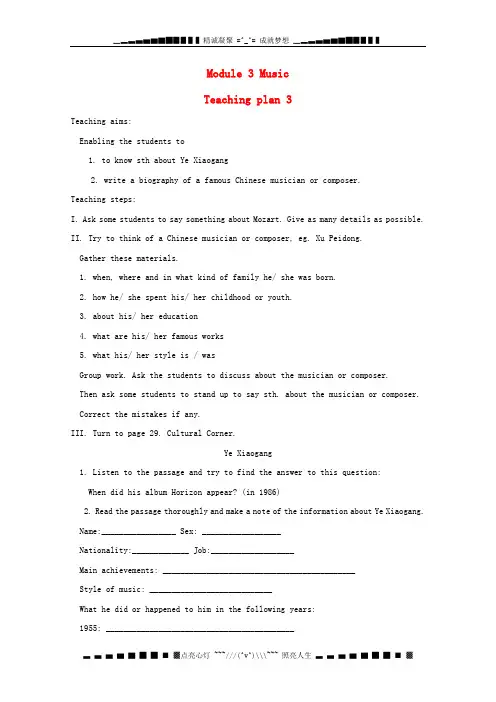
Module 3 MusicTeaching plan 3Teaching aims:Enabling the students to1. to know sth about Ye Xiaogang2. write a biography of a famous Chinese musician or composer.Teaching steps:I. Ask some students to say something about Mozart. Give as many details as possible. II. Try to think of a Chinese musician or composer, eg. Xu Peidong.Gather these materials.1. when, where and in what kind of family he/ she was born.2. how he/ she spent his/ her childhood or youth.3. about his/ her education4. what are his/ her famous works5. what his/ her style is / wasGroup work. Ask the students to discuss about the musician or composer.Then ask some students to stand up to say sth. about the musician or composer. Correct the mistakes if any.III. Turn to page 29. Cultural Corner.Ye Xiaogang1. Listen to the passage and try to find the answer to this question:When did his album Horizon appear? (in 1986)2. Read the passage thoroughly and make a note of the information about Ye Xiaogang. Name:_________________ Sex: __________________Nationality:_____________ Job:___________________Main achievements: ____________________________________________Style of music: ____________________________What he did or happened to him in the following years:1955: ___________________________________________From 1978 to 1983: ___________________________________________1985: ___________________________________________1986: ___________________________________________1996: ___________________________________________3. Check the answers with the whole class. Then ask one or two students to say sth about Ye Xiaogang with the help of the notes made.4. Language points:1) work as2) leading modern composers 主要作曲家leading article 社论the leading cause 主要原因a leading role 主角3) mix A with B= mix A and B togethermix win with waterNever mix with such people.mix up 弄混,弄错It’s common to mix him up with his brother.弄乱mix up the papersmix up those data4) receive many prizes5) part ofIV. Homework:Write a short passage about the Chinese musician or composer we talked about this period.。
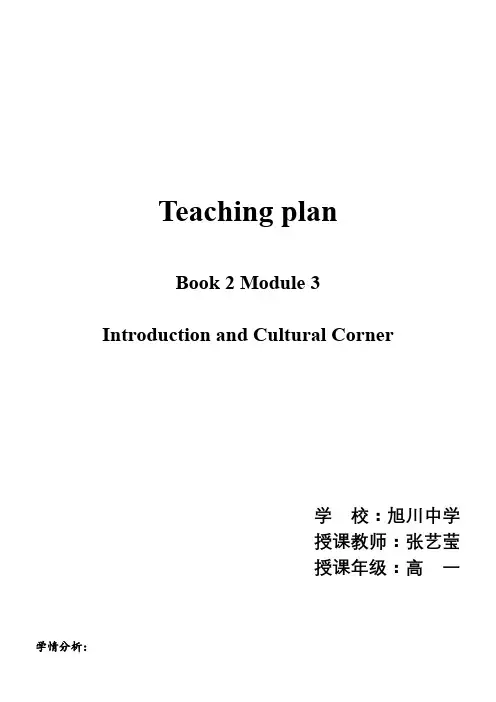
Teaching planBook 2 Module 3Introduction and Cultural Corner学校:旭川中学授课教师:***授课年级:高一学情分析:经过了较长时间的初高中英语课程衔接和适应,高一学生在单词记忆和阅读能力方面有了一定的提高。
但是学生对文本的理解还处于较为局限的范围,一篇文章读完后抓不住文章的重点内容以及要表达的情感价值观或者态度。
总之,学生读完后没有养成联系上下文思考问题以及概括文章核心内容的习惯。
英语课堂中如果有图片、音乐或者视频等教学资源的加入,学生们在该堂课上的学习兴趣会比平时高很多。
“音乐”这一话题也是学生所熟悉且热爱的日常生活的一部分,而且学生也了解一些有关音乐的词汇,因此单词的引入就较为容易。
Cultural corner部分的文章内容是有关音乐界著名人士的传记。
高中生对该类型的文章兴趣较为浓厚,但是如何把传记描述的内容有逻辑有条理的在脑海里清晰的呈现并形成完整的体系对学生们来说是一个难点。
因此,教学设计时的重点就要引导学生剖析文章,联系上下文,对文章有一个全局的把握。
教学内容分析:本堂课的教学内容是外研社高中英语必修二第三模块里的Introduction和Cultural Corner两个部分。
本模块的话题是“Music”。
通过对本模块的学习,学生可以了解古今中外的音乐家及其事迹,丰富音乐知识,提高学生的音乐素养。
Introduction部分主要通过活动来让学生复习和学习一些与话题music有关的词汇,比如乐器、音乐家和音乐流派等相关词汇。
学习单词的同时激发学生的学习兴趣。
Cultural corner部分学习一篇有关于作曲家叶小刚的人物传记。
该篇人物传记以时间线为线索介绍了叶小刚的生平经历与成就。
通过学习了解他的音乐生涯、经历和成就,同时还能够增强学生的民族自豪感。
Teaching Aims:1.Knowledge1). To learn some words about music2). To understand the elements and structure of biography.2.Ability1). To try to express the likes and dislikes about music.2).To master the reading skills of skimming and scanning3). To understand how to write a piece of writing about a person’s life.4). To improve the abilities of listening, speaking, reading and writing.3.Emotion and ValuesTo strengthen the national sense of pride.Important points:1)To master the words related to music.2)To learn to analyze and master biographical articles.Difficult point:1)To read with strategies of skimming and scanning.2)To analyze the text with a mind map.3)To learn to write a biography.Teaching steps:Step1 Lead-inStep 2 Introduction1. Share some pictures about the comments of music and an interview video to inspire students’ interest.2. Activity---competitionStep 3 Cultural Corner---Ye Xiaogang1. Pre-reading2. While-reading1). Skimming: choice question2). Scanning: draw a mind map3. Post reading1). work with students to conclude the structure of the biography.2). Make a summary about “how to describe a famous person” (how to write a biography).Step 4 HomeworkTeaching procedures:Step1. Lead-inListen to a song to relax the students and lead in the topic about music.Step 2. Introduction1. Share some pictures about the comments of music and an interview video to inspire students’ interest.2. Activity---competitionThe teacher will give students three topics about music and ask the whole class to think about words related to these topics. About the first topic, the teacher will divide the whole class into two groups to make a competition. Meanwhile, the teacher will find out two students from both groups to come to the blackboard to write down words that their group members mention. The winning group will receive a prize.Brainstorming: 1. Types of music2. musical instruments3. people related to musicStep 3. Cultural Corner---Reading1. Pre-readingA brief introduction to Ye Xiaogang to stimulate students’ interest.2. While-reading1). skimmingListen to the tape and read the passage quickly, and then choose the type of writing about the passage Ye Xiaogang.2). scanninga. Read the passage carefully and find out the numbers in this passage.1955:4 years old:1978-1983:1985:1986:1996:since 1993:b. Ask students to draw a mind map(思维导图)about the experiences and achievements of Ye Xiaogang according to these numbers. Then the teachers will share some productions with the whole class.3. Post reading1). Give students a brief introduction about Ye Xiaogang according to the original text and work with students to conclude the structure of the biography.“Ye Xiaogang, who was born in 1955, is one of a group of Chinese composers known as the New Tide. From 1978 till 1983, He studied at the Central Conservatory of Music of China. In 1985, there was a concert of Ye Xiaogang's symphonies in Beijing. In 1986, his album Horizon appeared and he is famous for mixing Chinese musical traditions with western forms and instrumentation. Besides, he is a members of Eclipse, perhaps the first independent music group in China which plays works by modern Chinese composers. Since 1993, he has worked part of the time in Beijing and in the US.”a.“who was born in 1955” --- his date of birthb.“…is one of a group of Chinese composers known as the New Tide.” --- his social statusc.“From 1978 till 1983, He studied at…Since 1993, he has worked part of the time in Beijing and inthe US.” --- his experience and achievement.2). Make a summary about “how to describe a famous person” (how to write a biography).a.Date and place of birthb.Statusc.Experienced.achievementse.Family backgroundStepWriting: describe Lang Lang from at least three aspects.板书设计:教学反思:对于高中阶段的学生,尤其是理科生而言,英语是一门较为枯燥的学科。
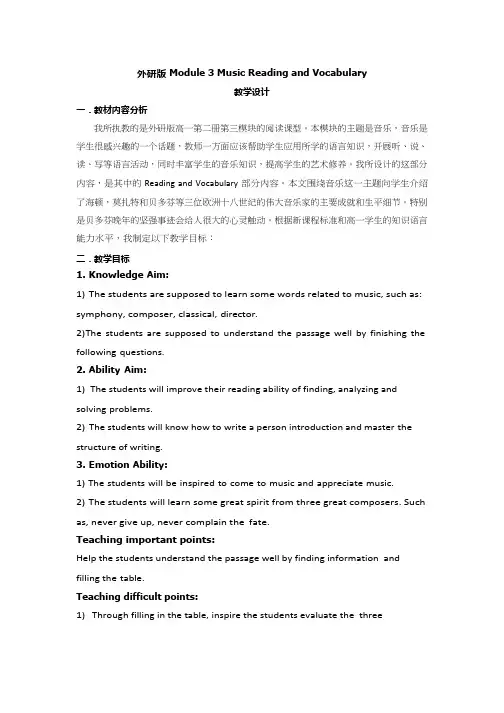
外研版Module 3 Music Reading and Vocabulary教学设计一.教材内容分析我所执教的是外研版高一第二册第三模块的阅读课型。
本模块的主题是音乐,音乐是学生很感兴趣的一个话题,教师一方面应该帮助学生应用所学的语言知识,开展听、说、读、写等语言活动,同时丰富学生的音乐知识,提高学生的艺术修养。
我所设计的这部分内容,是其中的Reading and Vocabulary 部分内容。
本文围绕音乐这一主题向学生介绍了海顿,莫扎特和贝多芬等三位欧洲十八世纪的伟大音乐家的主要成就和生平细节。
特别是贝多芬晚年的坚强事迹会给人很大的心灵触动。
根据新课程标准和高一学生的知识语言能力水平,我制定以下教学目标:二.教学目标1.Knowledge Aim:1)The students are supposed to learn some words related to music, such as: symphony, composer, classical, director.2)T he students are supposed to understand the passage well by finishing the following questions.2.Ability Aim:1)The students will improve their reading ability of finding, analyzing and solving problems.2)The students will know how to write a person introduction and master the structure of writing.3.Emotion Ability:1)The students will be inspired to come to music and appreciate music.2)The students will learn some great spirit from three great composers. Such as, never give up, never complain the fate.Teaching important points:Help the students understand the passage well by finding information and filling the table.Teaching difficult points:1)Through filling in the table, inspire the students evaluate the threecomposers and express what they have learned.2)The students master the structure of writing a person.教学过程设计Step 1. GreetingsStep 2. Lead-in (watch the video)活动:Act out the given situations and answer the question.The teacher broadcast the video.Give the following questions according to the song.1)Do you like the song ?2)Do you know who wrote this song? (引出其中的一个主人公莫扎特)1)老师播放音乐会视频营造轻松的课堂氛围,调动学生的积极性。
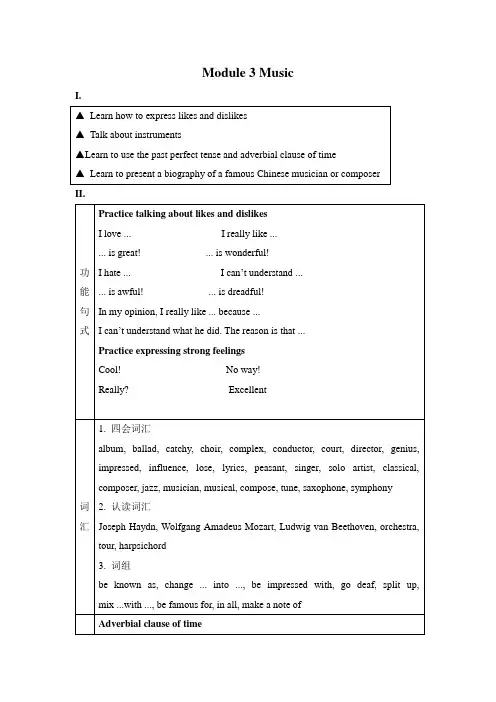
Module 3 Music I.II.Ⅲ. 教材分析与重组1. 教材分析本模块的话题是music,旨在通过模块教学使学生通过讨论古今中外的音乐家,增强他们的音乐欣赏能力, 并培养他们的评价能力。
在此基础上表达自己的好恶。
1.1 INTRODUCTION通过对乐器知识的了解,激发学生对本模块中心话题的兴趣;同时也使本模块的授课更具有针对性,从而培养学生的音乐审美能力。
1.2 READING AND VOCABULARY 介绍了国外的三位音乐家及他们的伟大成就,让学生在阅读中学习音乐知识,树立正确的评价观、人生观,为日后走向社会作铺垫。
课文重点讲解了三位音乐家的生平经历,以及他们对音乐所做的巨大的贡献。
通过阅读,学生学习了新的词汇和句型,提高了阅读水平,并能学习音乐家们坚持不懈的精神。
1.3 GRAMMAR 1 && GRAMMAR 2 学习并灵活运用由when, while, as 等引导的时间状语从句,然后对比过去时和过去完成时。
1.4 FUNCTION 通过问答形式表达对音乐的喜好,培养学生的评价能力。
1.5 LISTENING AND VOCABULARY 让学生通过听一段关于介绍英国历史上的披头士的文章来练习学生的听力能力,并且完成相关的练习题,然后介绍自己对音乐的感受及音乐在生活中的意义。
1.6 EVERYDAY ENGLISH 要求学生掌握如何表达自己最喜爱的音乐及如何听音乐的一些用语。
1.7 PRONUNCIATION 听并跟读语法材料中出现的句子,注意语调的起伏。
1.8 CULTURAL CORNER 了解著名音乐家叶小刚的生平经历及音乐成就。
他为中国音乐的发展做出了巨大贡献,了解他,引导学生向他学习,学习他勤奋钻研,不断追求完善的精神,更要学习他时刻不忘祖国,为国争光的爱国情怀。
1.9 WRITING 要求学生阅读一封来自Sandra的电子邮件,并根据一些问题写一封回信。
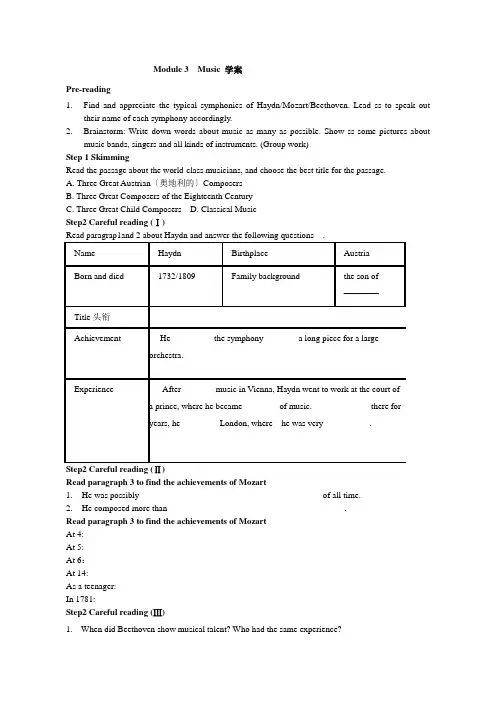
Module 3 Music 学案Pre-reading1.Find and appreciate the typical symphonies of Haydn/Mozart/Beethoven. Lead ss to speak outtheir name of each symphony accordingly.2.Brainstorm: Write down words about music as many as possible. Show ss some pictures aboutmusic bands, singers and all kinds of instruments. (Group work)Step 1 SkimmingRead the passage about the world-class musicians, and choose the best title for the passage.A. Three Great Austrian〔奥地利的〕ComposersB. Three Great Composers of the Eighteenth CenturyC. Three Great Child ComposersD. Classical MusicStep2 Careful reading (Ⅰ)Step2 Careful reading (Ⅱ)Read paragraph 3 to find the achievements of Mozart1.He was possibly _________________________________________ of all time.2.He composed more than ________________________________________.Read paragraph 3 to find the achievements of MozartAt 4:At 5:At 6:At 14:As a teenager:In 1781:Step2 Careful reading (Ⅲ)1.When did Beethoven show musical talent? Who had the same experience?2.Who encouraged him to move to Vienna? Why did Haydn encourage him to move to Vienna?3.What happened to Beethoven as he grew older? What do you say to Beethoven?Step3 recall the video---Why was there a silence in the film ?---Beethoven couldn’t hear applause (掌声) of the audience as a result of his deafness.Step 4 Retell the textKey wordsHaydnis known as , changed…… into, a long piece for a large orchestra, moved to , successfulMozartthe greatest musical genius, 35 years, more than 600 pieces of music, by the time, had composed, in 1781, was impressed withBeethovenshowed musical talent, was impressed by, in1791, wasn’t impressed by, it was …who, as grewolder, go deaf, continued composingStep 5 Match sentences with the composers, and find the supporting〔支持〕information from the text. Haydn Many heroes are young people since old days.Mozart Never give in to the difficulty on his way to successBeethoven Never care about where the heroes are from.Step6 Discussion (Group work)Summary : What have you learned from these great people?The leader of each group write the answers and show them to the class.Step 7 Homeworkexperienceat 3 started to learn ...at 15 moved to the US to learn ...at 17 popular around the world20xx World peace ambassador〔大使〕。
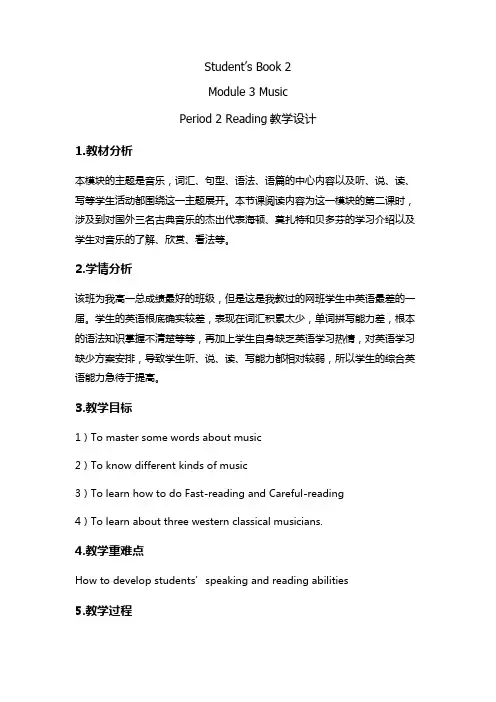
Student’s Book 2Module 3 MusicPeriod 2 Reading教学设计1.教材分析本模块的主题是音乐,词汇、句型、语法、语篇的中心内容以及听、说、读、写等学生活动都围绕这一主题展开。
本节课阅读内容为这一模块的第二课时,涉及到对国外三名古典音乐的杰出代表海顿、莫扎特和贝多芬的学习介绍以及学生对音乐的了解、欣赏、看法等。
2.学情分析该班为我高一总成绩最好的班级,但是这是我教过的网班学生中英语最差的一届。
学生的英语根底确实较差,表现在词汇积累太少,单词拼写能力差,根本的语法知识掌握不清楚等等,再加上学生自身缺乏英语学习热情,对英语学习缺少方案安排,导致学生听、说、读、写能力都相对较弱,所以学生的综合英语能力急待于提高。
3.教学目标1)To master some words about music2)To know different kinds of music3)To learn how to do Fast-reading and Careful-reading4)To learn about three western classical musicians.4.教学重难点How to develop students’speaking and reading abilities5.教学过程Step 1-Lead-in1.Do you like music ? And why?2.Brainstorm: What kinds of music do you know?3.Enjoy some pieces of music and guess: What kinds of music are they? Step2-Reading1.Fast Reading 训练反应Activity1: 1)Read the text quickly and choose the best answer.The text is mainly about_____.2)Divide the passage into 3 parts and tell whom each part talks about.2.Careful Reading训练反应Activity2 : Read Para.1 and answer the following question.How did Haydn change the form of symphonies?Activity3: Read Para.2 to answer the following question:What happened in the four places?Activity4: Read Paragraph 3-5:When did Haydn meet Mozart? What was their relationship? Activity5: Read Para.6-8 and choose the best answer.Activity6: Fill in the blanks .Step3-Consolidation〔训练稳固〕: Fill in the table.Step4-Discussion in groups(交流展示)How does music influence our life?Step5-Summary(归纳总结): What have you learned in this class?Step6-Homework (拓展延伸): Write 5 sentences to introduce your favorite singer.。

英语:Module3《Music》第3・5课时教案(外研版必修2)Periods 3, Function and GrammarTeaching aims: 1 To learn grammar rules2To use the grammar rules for correct communication3To study co-operatelyTeaching important points: To use the correct tense and the proper conj・Teaching difficult points: To use correctly the two tenses and the three conj.Teaching methods: Explanation and practiceTeaching procedure:Step I Lead-in by telling the class what happened to the Shenzhou XU|As Iscience and technology is developing rapidly, China has achieved a lot in the areaof.Shenzhou XII launchedl when/while Iscientists.engineers and the whole nation werewaiting and watching.|When| I came back home from school and heard the news, I couldn^thelp getting exciteed・ I feel proud of our country.Step II Grammar 11Make sentences with “when , while, come in , have a lesson”( Here is a picture of a classroom and a student coming in)A When he came in, we were having a lesson.B When we were having a less on,he came in.C While we were having a lesson, he came in.2Say the meaning of "as” in the following sentences.D As he was a child, he studied drawing.E As he grew older, he began to go deaf.F He listened to music as he walked・当…之吋随着一边…一边…3Answer the three questions.When we talk about a single event in the past,we use when as in A ・When we talk about a period of time in the past,we use when/ while / as as in B CD・We use as to refer to a progressive change as in E_F .4PracticeComplete the following sentences with "when ,while , as"(1) __ she was studying at school, she also sang in the school choir.(2) __ h e was living in Vienna, he studied music.(3) __ s he met bach,she was only 20 years old.(4) __ h e grew older, he found it more difficult to compose music(5) __ h e was playing in the orchestra, he met his wife.(6) __ h e was working in Hollywood, he became ill and died・(7) __ I listened to the violin solo, I fell in love with classical music.(8) __ they toured Europe for 10 years, they finnally decided to live in Austrilia・Step III Grammar 2 The past perfect tense1 Read the following sentences and summarise rules, paying attention to tenses. Fill in the blanks・After Liping had finished doing his homework, he turned on the TV.After they had got everything ready, they began to do the experiment.Before he came to our school, he had taught English for several years.Before his letter reached me, I had received his telephone call.They had finished the project by last month.1 had left the countiy by the time the letter reached me.had done before diddid after had donehad done by did/past time2 PracticeWorkbook Grammar ⑵⑶⑷Complete the sentences using the verbs in brackets and the past simple or past perfect tense.Step IV1Game Oral practice ,pair work・Ask and answer questions using all kinds of tenses・Example:-- When did you have your breakfast this morning?—At 6.—Have you prepared for the English lesson?- Yes, I have・ I have finished the exercises in the workbook・2Watch a vedio play.Step V Sum upAsk some students to make sentences using "when, while, as, before, after, by”.Step VI Homework: Present a biography of a famous Chinese musician or compose匚•上•上•上;•上•匕•匕•上•匕•匕•匕*7* 哼・Periods 4 Speaking and WritingTeaching Aims:L Knowledge and Skilla. To develop speaking ability by talking about likes and dislikes.b・ To learn about some vocabulary and knowledge related to music and composers.c.To develop writing ability by presenting a biography of a famous Chinese musician or compose匚d.Train the ability of collecting and dealing with information, and develop their abilities ofgetting new information, communication and cooperation.2.Emotion and Valuesa.To raise students5 interests in science and form the right cittitude towards all kinds of music.b.To help them know Chinese traditional music well and cultivate their interest in playing someChinese instrument.3.Character-building:a. To make them know how to enjoy different kinds of music.b・ Arouse their interest of playing some kinds of instrument and enrich their leisure time.4.Cross-cultural awarenessa.To help them know the difference between China and some western countries in instrume nts.b.Cultivate their awareness of cultural communication through the special language—music. Difficulties and Importance:a.To make the students understand and grasp the vocabulary and knowledge related to music.b.To enable the students to know how to use adverbial clause of time.Teaching Method:Task-based methodologyb・Communicative ApproachTeaching Procedures:Step 1 Pre-readingLook at the picture and answer the following questions.1.Who is he?2・ Have you ever know something about him?Step 2 While-readinga. SkimmingRead the passage quickly, and make a note of some basic information about Ye xiaogang・NameSexNationalityJobMain achievementStyle of musicSuggested answers:Name Ye xiaogangSex MaleNationality ChinaJob ComposerMain achievement received many prizes, home and abroadmixing Chinese musical traditions withStyle of musicwestern forms and instrumentation.b. Detailed readingRead the passage carefully and fill in the blanks with proper words. Find what Ye Xiaogang did or what happened to him in the following years:Time What he did1955From 1978 to 1983198519861996Suggested answers:Time What he did1955 bornFrom 1978 to 1983 studied al the Central Conservatory of Music ofChina.1985 held a concert of symphonies in Beijing・1986 his album appearedplayed with Italian musician Enrico Rava at the Beijing1996International Jazz Festive.Step 3. Post-readingDiscussio n・Are there any similarities between Ye Xiaogang and the European composers you have read about in this module?2・ Do you think it is a good idea to mix Chinese and western music?Step 4 Everyday Englisha.Listen to two people talking about the way they listen to music and answer the questions.1.How do they listen to it?2・ Are they happy with the way they listen to music?3.What does Anna offer to do for Tom?b.work in pairs. Discuss your favourite music and how you listen to i匸Step 4 Guided writingWrite a short passage of a famous singer in China一Han Hong.The following words may help you:1.sing well successful song writer2.bom inl971 in Tibet(西藏)3・ young watch her mother sing and dance4.at the age of nine professional2^ Jkfi勺)training in Beijing.5.in 1985 her first national prize6.write songs in 19937.song Hometown number one in ChinaHomework:1・ Finish writing the biography of Han Hong一a famous Chinese singe匚2・ Finish other exercises in this module・rT* rT* rT* rT* rT* rT* rTw rT* rTw rT* rTw rT* rTw rT* rTw rT* rTw rTw rTw rTw rTw rTw rTw rTw rTw rTw rTw rTw rTwPeriods 5 culture cornerTeaching aims:Enabling the students to2.write a biography of a famous Chinese musician or composer.Teaching steps:1.Ask some students to say something about Mozart. Give as many details as possible. IL Try to think of a Chinese musician or composer, eg. Xu Peidong.Gather these materials.1.when, where and in what kind of family he/ she was born.2.how he/ she spent his/ her childhood or youth・3・ about his/ her education4.what are his/ her famous works5.what his/ her style is / wasGroup work. Ask the students to discuss about the musician or compose匚Then ask some students to stand up to say sth. about the musician or composer.Correct the mistakes if any.IIL Cultural Corner.Ye Xiaogang1. Listen to the passage and try to find the answer to this question:When did his album Horizon appear? (in 1986)2.Read the passage thoroughly and make a note of the information about Ye Xiaogang・Name: _________________ S ex: ___________________Nationality: _____________ J ob: ___________________Main achievements: ______________________________________________Style of music: ______________________________What he did or happened to him in the following years:1955: ____________________________________________From 1978 to 1983: _____________________________________________1985: ____________________________________________1986: ____________________________________________1996: ____________________________________________3.Check the answers with the whole class. Then ask one or two students to say sth about Ye Xiaogang with the help of the notes made・nguage points:1)work as2)leading modern composers 主要作曲家leading article 社论the leading cause 主要原因a leading role 主角3)mix A with B= mix A and B togethermix win with waterNever mix with such people・mix up弄混,弄错It's common to mix him up with his brother.弄乱mix up the papers mix up those data4)receive many prizes5)part ofIV. Homework:Write a short passage about the Chinese musician or composer we talked about this period.。
Module3 Music Reading and vocabulary
Step1. Lead-in(导入)
Step2. Fast reading(快读)Read the passage quickly and choose the best title.
1. Three Great Austrian Composers
2. Three Great Composers of the Eighteenth Century
3. Three Great Child Composers
Step3. Careful reading(精读)
★ Read Part (Ⅰ) about Haydn and answer the following questions. (回答问题)
1. What is Haydn known as?
2. How did Haydn change the form of symphony ?
3. How long did he work in eastern Austria?
★ Read Part (Ⅱ) about Mozart and match the time with the right information.(信息匹配)
1)at a very early age a. toured Europe giving concerts
2)when he was 4 b. played the harpsichord in a concert for the Empress of Austria 3)when he was 5 c.showed musical talent
4)when he was 6 d. learned to play the harpsichord
5)by the time he was 14 e.started composing music
6)when he was a teenager f. composed many pieces for the harpsichord, piano and violin ★ Read Part (Ⅲ ) about Beethoven & decide if these sentences are true or false.(判断正误)
1. Beethoven was born in Austria.
2. Beethoven learned to play the violin and piano from his father, who was a singer.
3. Beethoven met Haydn in 1781.
4. Hadyn encouraged Beethoven to move to Vienna.
5. When Beethoven became completely deaf, he stopped composing.
Step4. Consolidation(巩固练习)
Three Great Composers of the Eighteenth Century
Haydn, who __ _____ __“the father of the symphony”, was the son of a peasant. He________the symphony ____ a long piece for a large orchestra. ______ ______ in
eastern Austria for 30 years, Haydon moved to London, _______ he was very successful.
Mozart was a composer, possibly the greatest musical genius ____ ____ _____ . He had ______ ______ from a very early age. By the time he was 14, Mozart had ________ many pieces for the harpsichord, piano and violin, ____ ______ _____for orchestras. Haydn was _________with Mozart when he first met him.
Beethoven was born in Bonn, Germany. He ________ musical talent when he was young. In his twenties, he met both Mozart and Haydn. However, it was Haydon who __________him to move to Vienna. ___ he grew older, he began to ___ ____. But he
________ _________ .
Step5. Role-playing(角色扮演)Work in pairs. Make a dialogue about the three composers. student A acts as an interviewer and student B acts as one of the composers.
The students can make the dialogue with the following clue.
Interviewer: Good morning, Mr.……Composer: Good morning. Interviewer: Would you mind me asking a few questions ? Composer: Of course, not. Interviewer: When……/ Where……/What…… Composer: ……
Interviewer: Thank you very much for your time. Composer: It’s my pleasure.
Step6. Homework According to the information, write a short passage about Jay Zhou.。